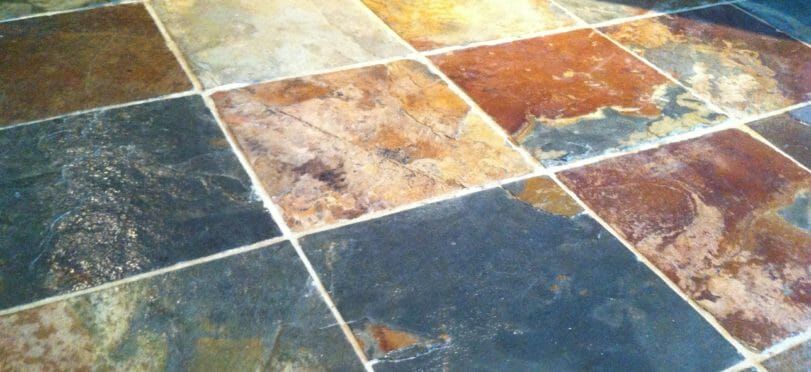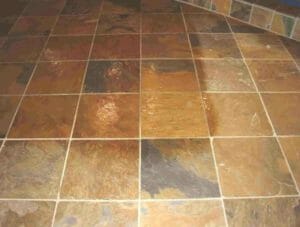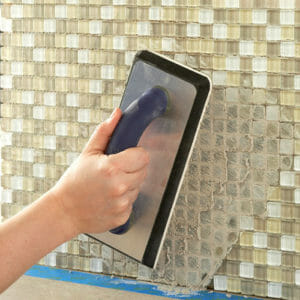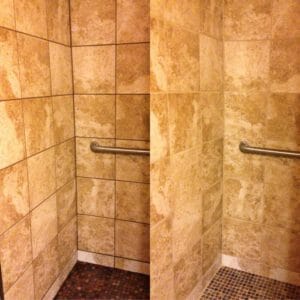Sealing Porcelain or Ceramic Tile

 To seal or not to seal porcelain tile, now is that the question?
To seal or not to seal porcelain tile, now is that the question?
One trying to find information on this will find that there is an array of different opinions scattered through the results that will come up through google. Some say yay and some say nay. We say it’s more of a personal choice and depends more on the surface of the tile.
Porcelain is renowned for its durability, and a textured surface can offer an impressive ‘R’ rating, but it can prove problematic to clean.
The high-low surfaces make it difficult, as a mop won’t dig out the dirt and will often ‘snag’ on the surface.
Matt finishes are smooth but there may be a slight surface texture, and even the tiniest surface undulation will collect dirt.
A sealant isn’t always recommended, suggested, or deemed necessary, but it offers a protective barrier that’ll prove to be prudent in the long run.
When sealing tiles, if they’re not completely clean the dirt or what was not cleaned of the tile will become trapped between the tile surface and the treatment. If one is really not paying attention during this process, they could one day look down and see a bug that has been trapped by the sealant. This one just looks unsightly, but will also affect the barrier’s integrity.
was not cleaned of the tile will become trapped between the tile surface and the treatment. If one is really not paying attention during this process, they could one day look down and see a bug that has been trapped by the sealant. This one just looks unsightly, but will also affect the barrier’s integrity.
It is the assumption of many customers that polished porcelain floor tiles don’t need sealing, but during the polishing process, micropores are opened up and become vulnerable to dirt and grime.
Some polished porcelains are sealed as part of the manufacturing process, to protect them during installation, but a further seal after a thorough builder’s clean is recommended, to offer additional protection for the tile and grout joint.
What types of sealers are there for porcelain or ceramic tiles?
There are two main types of tile sealers which are penetrating sealants and surface Sealants.
- A penetrating sealant absorbs into the tile or grout and forms a stain resistant shield just below the tile’s surface (most penetrating sealers won’t change the appearance of the tile).
- A surface sealant coats the top of the tile and grout. This forms a non-porous, stain resistant sealant. Surface sealers enhance the colors of the tile.
What grout should one use if they’re tiling or regrouting their shower?
 It is in a person’s best interest to use unsanded grout for the tile joints on the shower wall. Unsanded grout is used for thin grout lines varying from 1/8 to 1/16 which is what’s generally found in the showers that are tiled. Unsanded grout also makes it easier to work with vertical surfaces such as tiled shower walls. The lack of abrasive sand in unsanded grout also means you should use it for scratchable surfaces like glass or honed stone.
It is in a person’s best interest to use unsanded grout for the tile joints on the shower wall. Unsanded grout is used for thin grout lines varying from 1/8 to 1/16 which is what’s generally found in the showers that are tiled. Unsanded grout also makes it easier to work with vertical surfaces such as tiled shower walls. The lack of abrasive sand in unsanded grout also means you should use it for scratchable surfaces like glass or honed stone.
What is unsanded and sanded grout?
Well, sanded grout sounds like exactly what it is; grout that contains very fine sand.
Unsanded grout would be the opposite. It is grout that contains no sand in it. They both have their purposes.
Here’s something to help one figure out with goes where:
Recommendations For Use
Location/Use Sanded Grout Unsanded Grout
Bathroom or Kitchen Floor Yes Yes
Rectified Tile No Yes
Shower Wall No Yes
Shower Pan Yes Yes
Bathroom Wall No Yes
Polished or Honed Stone No Yes
How does one seal grout in the shower?
Here are 8 easy steps to help one in the process of sealing grout in the shower:
1. One should allow grout to cure for 48 to 72 hours.
2. The room should be ventilated, and one acquire rubber cleaning gloves and put them on. Then, dip a coarse scrub pad into a bucket of clean water. Scrub every grout line with the wet pad to remove loose debris. Wipe up the debris and water with a clean towel or a large sponge. Allow the grout to dry for the amount of time recommended by the sealer manufacturer, as drying times vary among products.
3. Pour the sealer into an applicator bottle. Fill the bottle completely to the top. Place the roller-wheel top on the bottle and tighten it securely.
4. Turn the applicator bottle upside down, so that the roller-wheel points toward the floor.
5. Roll the wheel down the center of the grout line and saturate it completely with sealer. Work in small sections and use dry paper towels to remove excess sealer from the surface of the tile. Drying sealer can leave a dull, hazy film on the surface of the tile. Allow the sealer to dry for the amount of time recommended by the manufacturer, usually 5 to 10 minutes. Remove standing sealer from the grout lines completely, using dry paper towels.
6. Move to the next small section of grout line and apply the sealer. Allow the sealer to dry for the same amount of time and remove excess from surrounding tiles with dry paper towels. Continue in this manner until every grout line has been sealed. Allow the sealer to dry for the full amount of time recommended by the manufacturer.
7. Use the same procedure to apply a second coat of sealer to the grout. Allow the sealer to dry completely. Multiple coats of sealer can be applied until you reach the desired coverage. The shower has been sealed adequately, when water beads on the surface of the grout, unable to penetrate.
8. Allow the sealer to cure for the full amount of time recommended by the manufacturer before using the shower.
Important materials one will require for the job are:
· Rubber Gloves
· Sponge
· Grout Sealer
· Bucket
· Clean Towel
· Course Scrub Pad
· Paper Towels
· Applicator bottle with a roller-wheel top